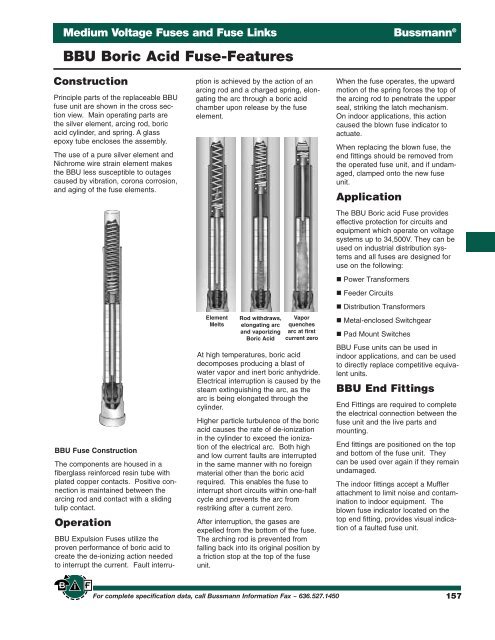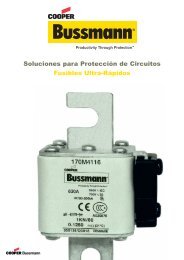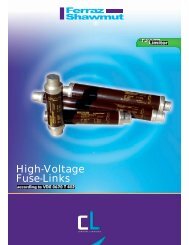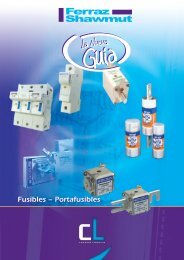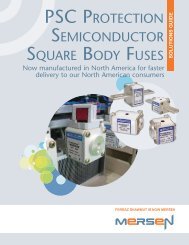Bussmann
You also want an ePaper? Increase the reach of your titles
YUMPU automatically turns print PDFs into web optimized ePapers that Google loves.
Medium Voltage Fuses and Fuse Links<br />
BBU Boric Acid Fuse-Features<br />
<strong>Bussmann</strong> ®<br />
Construction<br />
Principle parts of the replaceable BBU<br />
fuse unit are shown in the cross section<br />
view. Main operating parts are<br />
the silver element, arcing rod, boric<br />
acid cylinder, and spring. A glass<br />
epoxy tube encloses the assembly.<br />
The use of a pure silver element and<br />
Nichrome wire strain element makes<br />
the BBU less susceptible to outages<br />
caused by vibration, corona corrosion,<br />
and aging of the fuse elements.<br />
BBU Fuse Construction<br />
The components are housed in a<br />
fiberglass reinforced resin tube with<br />
plated copper contacts. Positive connection<br />
is maintained between the<br />
arcing rod and contact with a sliding<br />
tulip contact.<br />
Operation<br />
BBU Expulsion Fuses utilize the<br />
proven performance of boric acid to<br />
create the de-ionizing action needed<br />
to interrupt the current. Fault interruption<br />
is achieved by the action of an<br />
arcing rod and a charged spring, elongating<br />
the arc through a boric acid<br />
chamber upon release by the fuse<br />
element.<br />
Element<br />
Melts<br />
Rod withdraws,<br />
elongating arc<br />
and vaporizing<br />
Boric Acid<br />
Vapor<br />
quenches<br />
arc at first<br />
current zero<br />
At high temperatures, boric acid<br />
decomposes producing a blast of<br />
water vapor and inert boric anhydride.<br />
Electrical interruption is caused by the<br />
steam extinguishing the arc, as the<br />
arc is being elongated through the<br />
cylinder.<br />
Higher particle turbulence of the boric<br />
acid causes the rate of de-ionization<br />
in the cylinder to exceed the ionization<br />
of the electrical arc. Both high<br />
and low current faults are interrupted<br />
in the same manner with no foreign<br />
material other than the boric acid<br />
required. This enables the fuse to<br />
interrupt short circuits within one-half<br />
cycle and prevents the arc from<br />
restriking after a current zero.<br />
After interruption, the gases are<br />
expelled from the bottom of the fuse.<br />
The arching rod is prevented from<br />
falling back into its original position by<br />
a friction stop at the top of the fuse<br />
unit.<br />
When the fuse operates, the upward<br />
motion of the spring forces the top of<br />
the arcing rod to penetrate the upper<br />
seal, striking the latch mechanism.<br />
On indoor applications, this action<br />
caused the blown fuse indicator to<br />
actuate.<br />
When replacing the blown fuse, the<br />
end fittings should be removed from<br />
the operated fuse unit, and if undamaged,<br />
clamped onto the new fuse<br />
unit.<br />
Application<br />
The BBU Boric acid Fuse provides<br />
effective protection for circuits and<br />
equipment which operate on voltage<br />
systems up to 34,500V. They can be<br />
used on industrial distribution systems<br />
and all fuses are designed for<br />
use on the following:<br />
• Power Transformers<br />
• Feeder Circuits<br />
• Distribution Transformers<br />
• Metal-enclosed Switchgear<br />
• Pad Mount Switches<br />
BBU Fuse units can be used in<br />
indoor applications, and can be used<br />
to directly replace competitive equivalent<br />
units.<br />
BBU End Fittings<br />
End Fittings are required to complete<br />
the electrical connection between the<br />
fuse unit and the live parts and<br />
mounting.<br />
End fittings are positioned on the top<br />
and bottom of the fuse unit. They<br />
can be used over again if they remain<br />
undamaged.<br />
The indoor fittings accept a Muffler<br />
attachment to limit noise and contamination<br />
to indoor equipment. The<br />
blown fuse indicator located on the<br />
top end fitting, provides visual indication<br />
of a faulted fuse unit.<br />
For complete specification data, call <strong>Bussmann</strong> Information Fax ~ 636.527.1450<br />
157


